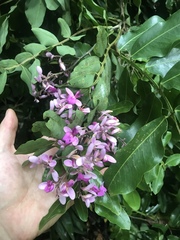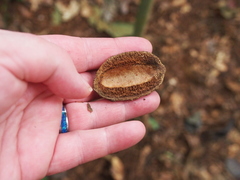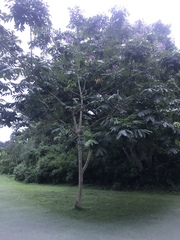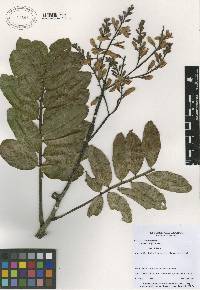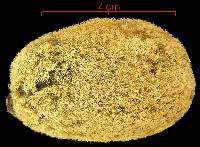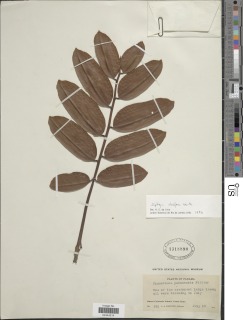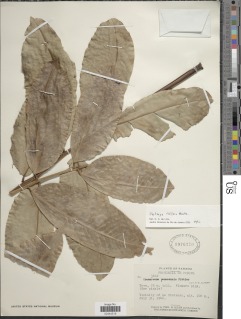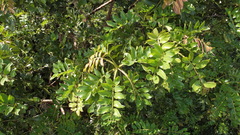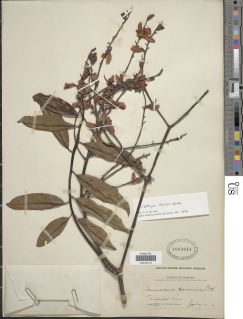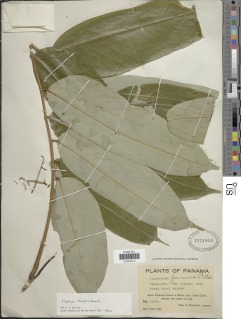

|
|
|
|
Family: Fabaceae
almendro de montaña, more...almendro, almendro, almendro de corozo, almendro de montaña
[Dipteryx panamensis (Pittier) Record & Mell, moreOleiocarpon panamense (Pittier)Dwyer] |
Description: A tall forest tree with an immense, straight trunk with rounded buttresses. At Barro Colorado, the tallest tree measured to date -- 52.7 m -- was this species. The bark is yellow colored and densely granular. Leaves are compound, usually with 11-13 leaflets that alternate with one another; often, the leaf rachis (carrying the leaflets) extends beyond the last leaflet. The leaflets are assymmetric, with the leading half wider than the trailing half. The petiole and leaf rachis are winged, although the wings are narrow. Reproduction: Dipteryx is irregularly deciduous towards the end of the dry season, with some trees losing most of their leaves. Flowers are purple, pea-like, produced above the foliage in June; they are conspicuous at a distance. Fruits have a single, hard seed with a thin layer of brown pulp surrounding it; they are typically found on the ground with the pulp gone, and often with a hole chewed in the wall. During December and January, this tree's seeds are a staple for mammals at Barro Colorado Island, the agoutis can frequently be heard gnawing at the seeds at the base of the big Dipteryx. Distribution: A conspicuous canopy emergent at Barro Colorado and Soberania, where it is fairly common. Only seen rarely at other sites on the Atlantic half of the isthmus. Not known south of Soberania, and not seen along roads or in open areas. Similar Species: A conspicuous and oft-studied tree at Barro Colorado, it is easy to learn either from the trunk, with yellowish bark, or the very distinctive leaves. Beneath big trees, the leaf rachis can usually be found, and recognized from the small wing even if the leaflets are fallen. Uses: The wood is hard and valuable for a variety of contruction purposes. Dipteryx grows fairly rapidly in open areas, and has been tested in plantation in Costa Rica. Descripción: Árbol de 20 a 40 m de alto. Copa amplia y redondeada. Tronco con raíces tablares de mediano tamaño en la base. Corteza exterior lenticelada y de color marrón. Hojas imparipinnadas y alternas, con 10-20 folíolos, alternos en el raquis. Folíolos de 7-15 x 3-8 cm, oblongos o elípticos, asimétricos, con ápice acuminado, bordes enteros y base desigual. Los folíolos son verdes en el haz y blancos o grises por el envés. Estípulas deciduas. Pecíolo de 6-12 cm de largo y acanalado o alado en la parte superior. Raquis alado y terminado en una prolongación aguda después del último folíolo. Flores rosadas o ligeramente moradas. Frutos en drupas obovadas, de 4-6 cm de largo, verdes o marrón. Semilla de textura pubescente. Datos Ecológicos: La especie crece a bajas y medianas elevaciones, en bosques húmedos o muy húmedos. En Panamá se encuentra en las provincias de Bocas del Toro, Colón, Darién, Panamá y la comarca de Guna Yala. Deja caer sus hojas durante la estación seca, pero las repone a inicios de la estación lluviosa. Florece y fructifica de mayo a enero. Las flores son visitadas por abejas, mariposas y otros insectos. Los frutos forman parte de la dieta de monos, ñeques, ardillas, saínos, venados, loros y guacamayas. Los murciélagos del género Artibeus se alimentan del pericarpo del fruto y dejan caer las semillas en pequeños grupos debajo de sus comederos. Los gorgojos de la familia Bruquidae perforan la cubierta dura de las semillas para depositar sus huevos. Especies Parecidas: A menudo se confunde con LK sap1sa Sapindus saponaria LK2 , pero en S. saponaria las flores son blancas y los frutos son drupas globosas, en grupos de 2 ó 3, verdes, tornándose amarillos y rodeados de una bolsa mucilaginosa y transparente al madurar. También se puede confundir con LK diplpu Diplotropis purpurea LK2 , pero en D. purpurea el pecíolo y el raquis no son alados, y los frutos son legumbres aplanadas. Usos: La madera se utiliza en construcciones de pisos, pilotes para minas, puentes, durmientes de ferrocarril, vagones, quillas de barcos y mangos de herramientas. Los indígenas de la provincia del Darién tuestan las semillas para consumir los embriones, también fabrican antorchas con los frutos. Tree, to 40 m tall; trunk more than 1 m dbh, usually weakly buttressed; outer bark light brown, thick, hard, the surface granular and loose; inner bark tan (becoming brown in time), the cells isodiametric. Leaves alternate, paripinnate; stipules conspicuous, linear, to ca 15 cm long, l cm wide, caducous; petioles flat, canaliculate at base, 6-15 cm long; petiole and rachis revolute-winged; rachis 15-30 cm long, continuing past the terminal pair of leaflets into a conspicuous flange 2-7 cm long; petiolules pulvinate, 4-6 mm long, subtended by acute stipels ca 4 mm long; leaflets 10-16; alternate on rachis or opposite, elliptic to oblong, acute to retuse at apex, +/- inequilaterally obtuse at base, 7-22 cm long, 2.5-7.5 cm wide. Panicles terminal, to 40 cm long; pedicels 3-5 mm long, expanded at apex; flowers conspicuous, red-violet, ca 2 cm long; calyx with 2 lobes, these much expanded, obliquely oblong, spreading laterally, to 1.7 (2) cm long, the carinal and lateral teeth very reduced; calyx orchid-colored, sparsely punctate and puberulent; standard to 1.5 cm long and 1.3 cm wide, emarginate, green at base medially, surrounded by a dark band of red-violet, the claw short and strongly recurved; stamens to 1.4 cm long, subequal; filaments fused in basal two-thirds, directed upward near apex; style a little longer than stamens, directed sharply upward; ovary glabrous. Drupes borne on thick stipes ca 8 mm long, plump, oblong, ca 6 cm long and 3 cm wide, at first gray-green-pubescent, becoming brown-pubescent, at maturity filled with an oily, fragrant liquid, the liquid crystalizing when the fruit dries; seed 1, flattened, ca 5 cm long and 1.5 cm wide. Croat 6084, Foster 1326, Hladik 441. Common to locally abundant in most areas of the forest. Flowers from May to August, generally in July. The fruits develop to mature size by the late rainy season, with most maturing from January to April. Leaves are deciduous during part of the dry season. Recognized by the light granular bark. Bees are very active visitors when the tree is in full flower. The fruits are taken by white-faced, spider, and howler monkeys as early as November (Hladik & Hladik, 1969). White-faced monkeys eat the fruits mostly from January to April (Oppenheimer, 1968). removing a part of the mesocarp, surrounding. the seed before discarding the remainder. Fruits are also taken by bats, rodents, and coatis (R. Foster, pers. comm.). Bocas Species Database Distribution: Isla Colon Characteristics: Tree |
|
|
|











